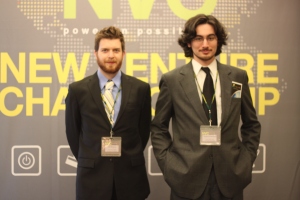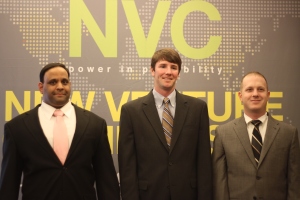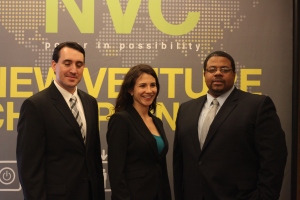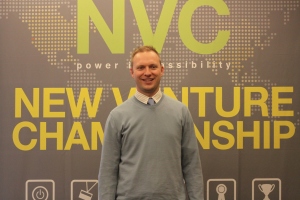When New Venture Championship Managing Director Terry Sebastian spoke to the impressiveness of the competitors last night, he placed high expectations amongst the twenty teams presenting today.
The teams did not disappoint.
Each team presented with confidence, poise, and professionalism.
We were able to sit in on 16 of the 20 semifinal presentations. Here is a summary:
R2EV – Boise State

R2EV consists of Alex Livingston, Thomas Schoeck and Marcel Wermeckes
R2EV of Boise State was a part of the first track that presented at 8:45 this morning. The team began by pitching their update to the traditionally expensive Uninterrupted Power Supplies (UPS) systems that are needed to supply companies with backup electricity when the power goes out.
The trio employs their patent-pending lithium technology to produce a battery with a lifespan of three times the battery life and four times the power available as the current product. R2EV has pilot programs already set up in a large grocery chain, but have come to the NVC to perfect their business plan that will allow them to access a 60 billion dollar market. They have plans to partner with the U.S. Government’s green energy initiative to cut costs and help the planet.
Ordoro – University of Texas at Austin

The Ordoro team consits of Jagath Narayan, Sangram Kadam and Naruby Schlenker
The Ordoro team has been bootstrapping their company to simplify the process that over 500,000 small online businesses go through to manage their inventory and sales. The University of Texas at Austin team sets out to replace the clunky and incomplete order management systems available. The trio has made progress by creating a simple, web-based inventory organization program to simplify sales and make business owner’s lives easier.
The team changed the pace of the pitch by throwing questions at Judge Steve Cord to make their presentation more clear and understandable. After Ordoro’s conclusion, the team said, “The variety of the competition is great.” They also credited the judges with giving them “great feedback.”
Microfluidic Innovations LLC – Purdue University

The Microfluidic team poses on the NVC stage
Microfluidic Innovations LLC presented their patent-pending proprietary lab-on-a-chip that can be reprogrammed to serve the purposes of academic research labs as well as major companies. Their groundbreaking technology shortens the time needed by labs to run experiments from 3-6 months to 3-6 hours. All of this is done in a cheap and affordable manner.
The team said that although they had to simplify their pitch to make the science-heavy process relevant to the judges, “the feedback was still very helpful.”
CyrusPath – San Diego State University

Craig Stern entertains the crowd during the Elevator Pitch conversation
CyrusPath bills itself as “the new wave of language acquisition.” The startup backs up its claim with a novel implementation of language translation into text messaging.
Stern proposes that CyrusPath can help the estimated one billion people currently attempting to learn a new language. This equates to about 80 billion dollars in sales! Stern hopes to break into the market with innovative techniques such as text-to-speech and colloquialism translation.
A2K Technologies – University of Manitoba

University of Manitoba members Andrea Legary, Anocha Jivanuwong and Katherine O'Rourke pose on the NVC stage
A2K Technologies, traveling from the University of Manitoba in Canada, introduced its product, ColoSpec, to its judges. ColoSpec is an alternative to the standard colonoscopy. This simple-to-use product can help lower the rate of colon cancer- one of the most preventable types of cancer. With a 92% accuracy rate, ColoSpec looks to help increase the rate of adults ages 50 and older that currently get tested annually.
Nalu Solar – University of Michigan

University of Michigan teammates Jennifer McLaughlin, Prashanth Prasad and Imogen Taylor on the NVC stage
Nalu Solar shined in their 15-minute presentation about their innovative software that allows big businesses and do-it-yourself types to build building-specific solar panels while guiding them through every step from visualization to creation. The University of Michigan-based team’s pitch focused on the gap that would be filled by the ease and affordability of their software that would bring back an estimated 150% return on investment.
“More than jumping on the DIY bandwagon, it’s about filling a market need,” Douglas Hutchings of Nalu Solar said.
Green Valley Solar – University of Arkansas

Green Valley Solar on the NVC stage
Green Valley Solar, with a catchphrase of “Solar has never been so green.” The team uses a patented groundbreaking technology to reduce the price of silicon-based photovoltaic devices.
Green Valley Solar has created 26% cheaper solar panels that are more efficient than the panels currently available. The team, traveling from the University of Arkansas, hopes to market their products for large companies, and has already entered into a deal with Sanyo.
Marere Pure Water – Brigham Young University

Marere Pure Water from Brigham Young University
Marere Pure Water has created a business around helping water-deprived East Africans. The participants, hailing from Brigham Young University, plan to implement their new ultra-cheap, easily accessible, biodegradable and clean 18oz bags of drinking water in Kenya, where dirty water leads to 50-70% of disease.
Marere Pure Water argues that bags of water are vital for the health of Kenya and yield a 74% profit margin. The team has already made major plans for implementation, and is partnered with the Ambassador of Kenya. One judge was surprised at the completeness of the plan, saying, “I walked in here very skeptical, and I’m walking out of here very impressed.”
NanoShield – Georgia Institute of Technology

The NanoShield team poses for a team picture
NanoShield invented a safe, effective and low-cost proprietary coating technology that doubles the useful life of central venous catheters (CVC), thereby reducing the need for surgical interventions and the thousands of dollars of costs they incur.
With great eye contact and voice projection, team members Nikhil Patel, Andy Sanders and Jake Sisley clearly identified that 75% of CVC become blocked from health hazards within three months. Providing both remedial and preventative solutions, NanoShield is of high value to an intravenous market and provides a $3 to $4 billion saving each year in the U.S.
The judges shot out tough questions for NanoShield, but each member answered with educated insight. NanoShield has no current formal agreements but foresees obtaining their license within the next eight months.
When asked about their presentation, NanoShield teammates and their adviser felt very prepared for the Q&A session in part because of yesterday’s practice round. Adviser Margi Berbari was excited with her team and says the group did “phenomenally!”
Mosaic Genetics – University of Oregon

Mosaic Genetics presents during their semifinal round
Mosaic Genetics LLC is revolutionizing cancer research, one mouse at a time. The trio from the University of Oregon is bringing to market a new drug discovery tool, which will allow scientists to unlock the secrets of cancer at the cellular level. Catering to scientists’ research, Mosaic Genetics LLC crafted the LumiMouse – a new model, single cell view that enables cancer to develop in a natural location.
Providing detailed examples about their competitors, Mosaic Genetics LLC has developed their marketing strategy around academic validation with targeted researchers and commercial customers. Teammates Elizabeth Holsapple, Nick Boehm and Yonatan Schultz equally answered the judges’ Q&A session promptly and efficiently.
SafeSnip – Tulane University

SafeSnip team members pose on the NVC stage
Tulane University students William Kethman, Stephanie Roberts and Alex Chan presented their invention, SafeSnip, and wowed judges with their product and devotion. SafeSnip is a disposable, plastic medical device that improves birthrates by revolutionizing the way doctors cut umbilical cords.
SafeSnip, a one-time use device, was developed with a plastic blade based on sheer force that prevents disease growth on the umbilical cord. With an untouched market space, SafeSnip will target both developing and developed countries, focusing primarily in Bangladesh, where there is a high population, high rate of infant mortality and majority of births globally.
The team’s manufacturing strategy focuses on a plastic injection mold, which is their primary causation for funding. Luckily, the product is very cheap to produce, allowing the potential to help many in the future.
Thermal Conservation Technologies – University of Illinois at Chicago

The Thermal Conservation Technologies team consists of Laura Kilbanow, Jacob Kist and James Parks
Thermal Conservation Technologies wants to help truck drivers limit their negatives. The start up helps limit fuel usage, allows for more product space, and even qualifies for a tax credit. The early-stage company from the University of Illinois-Chicago is committed to energy preservation and sustainability through the utilization of high-performance vacuum insulation.
The first application is Klimate Kontrol, which reduces operating costs by up to 50% and increases carrying by up to 27% due to thinner insulation. Team members Laura Klibanow, Jacob Kist and James Parks were on point during their presentation. With an impressive presentation, poise and a slide show that affectively aided rather than guided their presentation, Thermal Conservation Technologies was well prepared and enthusiastic about this trucking dilemma.
Klimate Kontrol will vastly contribute to decreasing the national use of diesel fuel and address environmental fines, food quality awareness and increasing raw materials. With trusted and expert partnerships, Thermal Conservation Technologies project operators will see ROI by the end of quarter three and a 9X ROI for early investors!
Beyond Lucid – Carnegie Mellon University

Carnegie Mellon holds up their MediView banner on the NVC stage
46.4% of patient data is lost during the hand off into the emergency room. Beyond Lucid of Carnegie Mellon University plans to close this gap between ambulances and hospitals by introducing MediView, a healthcare IT system that securely, remotely, and wirelessly transmits real-time vital patient data to doctors inside a hospital emergency room. All of this occurs while patients are still in the ambulance en route to the hospital.
MediView collects vital data by using sensors and materials that EMT workers are already familiar with. With little change and much to gain, Beyond Lucid is looking to save lives by enhancing effectiveness of ambulance travel.
NanoMark Therapeutics – Louisville University

The NanoMark Therapeutics team consists of Sham Kakar, Gary Degen, Cohin Kakar, Dave Noack and Viji Sundar
In 2009, more than 15 thousand women died from ovarian cancer and more than 21 thousand new cases were diagnosed. Though explanations for cancer remain a mystery, scientific innovators from the University of Louisville have developed a treatment alternative to the side effects caused by today’s other leading drugs.
NanoMark Therapeutics presented AUra – a uniquely targeted cancer drug with low toxicity, specialized hormone surface and ability to kill cancerous cells while minimizing the death of healthy cells. Compared to other leading drugs in animal testing, AUra’s competitors killed less than 70% of cancerous cells, whereas AUra was able to kill 95%, and at a fraction of the cost. Chemotherapy drugs tend to cost as much as $100,000, but AUra treatment would cost almost half that, at around $45,000. The future of AUra looks bright for the NanoMark Therapeutics team and ultimately, the human race.
Cortical Concepts – Johns Hopkins University

The Johns Hopkins team, Cortical Concepts, takes the NVC stage
Osteoporosis and low bone mass debilitate the lives of almost 52 million U.S. women and men aged 50 and older. It’s being estimated that by the year 2020 this figure will climb to over 61 million.
In a spinal fusion, titanium screws and rods are placed into the vertebra, which decompress the nerves around the area and destabilize the spine. However, placing these screws into the vertebra of someone with osteoporosis can be compared to “putting a screw into drywall”, says Nicolas Martinez, which is why these screws have difficulty stabilizing and tendency to toggle out.
A team of engineers from John Hopkins University has patented a solution to increasing the fixation strength of the screws in this procedure for those with the disease: the Cortical Anchor. This team calls themselves Cortical Concepts. Already in communication with the FDA Director of Spine, the Cortical Anchor has already sparked excitement amongst the medical community and made a lasting impression on the New Venture Championship.
Bombyx Technologies – Cornell University

The lone Cornell University representative, Ben Rollins, takes the stage.
Benjamin Rollins, the CEO of Bombyx Technologies, conveyed an earnest passion for eye care technology by beginning his presentation with the story of a friend who slept in contact lenses and torn her corneas. However, his friend’s compelling trauma is not uncommon; Corneal injuries like this blind nearly 2 million people each year, and have led Rollins and his partner Brian Lawrence to pioneer a preventive solution.
Inserted just like a contact lens, their healing bandage is comprised of silk proteins that remarkably adhere to the eye to repair soft tissue and rapidly dissolve. The bandage was developed to heal chronic eye wounds and reduce chances of vision loss by emphasizing the body’s natural healing process. In contrast to a standard eye procedure, which can cost as much as $5.1 million, physicians would be able to sell this product for as low as $40. Bombyx Technology, traveling from Cornell University, has come a long way since its founding in 2009, and it would seem from their participation in the New Venture Championship this year that the eye care industry has a lot more to look forward to.






















